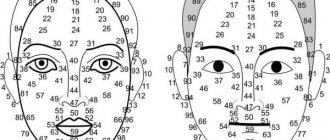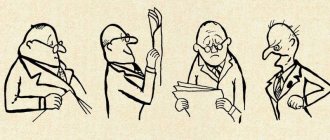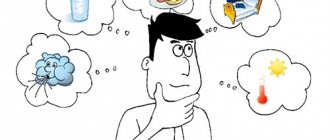Good afternoon or evening, dear readers. Each of us has an individual character, and of course, there are no people of the same type in the world. Scientists have long proven that even twins differ in character type, despite their similarity and upbringing using the same method.
Do you think that you have a good understanding of people and see right through them? Actually this is not true. What kind of character is a person? This can be judged only after a complete study of all types and highlighting the main parameters.
Definition and general characteristics of the concept
Character is a set of stable traits that determine a person’s behavior, his lifestyle, habits, and reactions to various situations. Character is not an innate component of the psyche, but is formed throughout life. The basis for the formation of character is biological characteristics: gender, type of temperament, set of genes. Refracted through the prism of education and individual development, they form a unique psychological picture.
The word “character” translated from Greek means “imprint, seal.” This is what distinguishes a person from other people, makes him unique and inimitable. It is impossible to meet two people with absolutely identical characters.
Character plays a decisive role in our lives. Everything we do, what we think, what emotions we experience is determined by our character. This is a kind of set of patterns fixed in the psyche that are designed to simplify our existence. Imagine: faced with the same situation every time, we would have to re-evaluate it, build a behavior strategy, and analyze the consequences. Character allows you to optimize this process.
Knowing a person's character well, you can almost accurately predict his behavior.
Character traits
Those traits that most often appear in similar life situations are character traits.
For example, a person usually behaves friendly and affable with others, but one day he breaks down and becomes rude. In this case, rudeness is not a character trait. This is a consequence of a situational factor. Most likely, the person was tired or upset. But friendliness can be fully attributed to the stable traits of his character.
All traits are usually divided into three groups depending on their focus. Each group also has positive and negative traits.
- Attitude towards yourself
This group of traits reflects a person’s attitude towards his own self. These include self-respect, pride, modesty, self-criticism, vanity, arrogance, pride, etc. The combination of these characteristics determines how a person positions himself in life, what place he places himself in relation to other people, how he evaluates his successes and failures, and what his goals are. chooses.
- Attitude towards other people
These are character traits associated with social interaction. Positive ones include responsiveness, friendliness, sociability, altruism, sensitivity, respect; negative ones include snobbery, contempt, isolation, callousness, and cynicism. The effectiveness of communication directly depends on these traits.
- Attitude to activity
These include hard work, responsibility, activity, diligence, creativity, accuracy, and perfectionism. And also laziness, passivity, irresponsibility. These traits are manifested in professional activity, in a person’s attitude to affairs and responsibilities.
The combination of traits from these three groups forms the character structure and a unique psychological portrait of a person.
Personal status
Character is adjusted throughout a person’s life. Lifestyle includes how a person thinks, feels, and acts in certain situations.
With the formation of a lifestyle, the person himself is formed. Of no small importance are the life circumstances and social conditions that take place in the lives of each of us.
However, character formation takes place in different groups (class, family, group of friends, team at work). Character will depend on the status of the individual in the team, as well as on what values are supported by the reference group.
The team creates favorable conditions for the development of the best character traits, and since this is a mutual process, the team itself also changes thanks to the individual. Character itself determines a person’s life values and position.
Character Formation
Scientists have for many years considered character to be an innate component of the psyche. This hypothesis was subsequently revised. Today there is no longer any doubt that character is formed throughout life. This idea was first expressed by the English philosopher John Locke.
Character begins to be formed immediately after birth. At this stage, a basic attitude towards trust or distrust in the world is formed. It is very important to surround the baby with love and care, to satisfy all his vital needs in a timely manner, and to take an active part in development.
The child grows up and begins to actively explore the world. Parents play the role of mediators and guides in this process. Their authority for the child is enormous. They have the strongest influence on the formation of his character. A child acquires some traits as a result of imitation, and some are formed as a result of targeted training.
After three years, the child’s social circle expands, peers and new adults appear in it. Character traits associated with social interaction begin to form: sociability, kindness, generosity, responsiveness.
When a child goes to school, adults’ assessments of his actions begin to play an important role in his life. An idea of what is good and what is bad is formed. Active socialization occurs, and the role of parents in the further formation of character begins to decline. The child manifests himself in vigorous activity, and the traits associated with it begin to develop: hard work, responsibility, initiative, punctuality.
Adolescents are actively developing moral, ethical and volitional qualities. By adulthood, the character is, as a rule, already fully formed. In the future, only adjustments to its individual features occur.
Thus, we can identify the main factors influencing the formation of character:
- parental education;
- cultural values proclaimed in society;
- personal example of people significant to a person;
- public opinion;
- self-development.
How is character different from temperament?
These two concepts are often confused or identified with each other. Let's be clear. Character and temperament are not the same thing, although they are closely related.
The first and most significant difference is that temperament is an innate indicator, and character is acquired.
The type of temperament is determined by the characteristics of the nervous system of each individual. Based on the combination of such general characteristics as strength, balance, and mobility of the nervous system, 4 types of temperament are distinguished:
- Sanguines. Strong, balanced, mobile nervous system. They are characterized by sociability, optimism, energy, and activity.
- Cholerics. Strong, unbalanced, mobile nervous system. They are characterized by high emotionality, quick temper, determination, and sociability.
- Phlegmatic people. Strong, balanced, inert nervous system. Phlegmatic people are slow, calm, efficient, and withdrawn.
- Melancholic people. Weak, unbalanced, inert nervous system. Melancholic people are vulnerable, sensitive, anxious and withdrawn.
Temperament is the basis on which character is formed. However, one should not assume that temperament completely determines him. The human psyche is very plastic - it can adapt to any conditions. People with different temperaments may have similar character traits, they will just manifest themselves differently.
For example, let’s take the quality of determination. Choleric people go straight to their goal. Any obstacles ignite sporting anger and passion in them. Sanguine people act methodically and confidently, do not give in to emotions and weigh every step. Phlegmatic people move towards the goal according to the principle “the slower you go, the further you will go.” Melancholic people have to constantly push themselves emotionally in order to maintain a high level of motivation.
There are traits that are more likely to develop in certain temperament types than others. But this does not mean that a person cannot go against the flow and shape them consciously through volitional efforts. Character can mask some of the innate manifestations, enhance others and inhibit others due to the formation and strengthening of new reflex connections.
Therefore, you need to constantly work on your character: get rid of bad traits and cultivate good ones. This is an interesting and creative process. Treat it like a game.
Handwriting
Graphology is a science that studies all the diversity of handwriting. It says that there are no absolutely identical handwritings, but all of them can be conditionally combined into certain groups according to certain criteria. As it turns out, people with similar characters have similar ways of writing signs and letters.
Absolutely everything affects the characteristics: the size of the letters, their shape, slope, distance between them, spaces between words, pressure on the paper, indentation from the margins.
- The size of the letters speaks of the openness of nature. If the letters are large and sweeping, then you have a creative person in front of you. Such people are usually impulsive, quick to act, pay little attention to details or advice, and are more interested in the goal. By nature they are warriors, rebels, who disagree with society. But small symbols speak of a person’s secrecy, the closedness of the soul. Such natures are very stubborn, have good mental analysis skills, are friends with the exact sciences, but prefer their company to a crowd of people. Very small letters indicate scrupulousness, even greater secrecy and detachment.
- The shape of the symbols characterizes the social character of a person. Owners of angular icons are most often stubborn people who disagree with other people's opinions. They fight for their complete independence from others, but at the same time they are very faithful in friendship. Those who prefer smooth transitions and roundness of symbols are soft, warm-hearted natures. They are always ready to lend a hand to someone in need, they know how to calm and give advice. People who combine different forms are ideal inhabitants of society, since they combine vital energy with kindness and strength of mind.
- Pressure on paper plays an important role when analyzing characteristics. So strong pressure is typical for choleric people, who like to constantly prove something, argue, keep promises, and set goals. And dim letters on paper speak of uncertainty and anxiety of melancholic people.
- Spaces between words, as well as margins, indicate the ability to share. Greedy people can produce handwriting with small spaces and indentations from the margins, it seems as if they feel sorry for the paper. Large indentations indicate the generosity of nature.
What is character accentuation
Accentuation is an extreme degree of expression of some specific character traits. A person with accentuation of character is mentally healthy, but on the very border of the norm.
Under unfavorable conditions, accentuation can develop into a mental disorder, leading to alcoholism, drug addiction, deviant behavior and suicide.
Accentuations are most common among teenagers. According to statistics, 95% of boys and girls aged 14–17 years have sharpened, hypertrophied character traits. With age, this figure decreases to 60%.
Accentuations cause personality disharmony, complicate socialization and general adaptation, and reduce productivity in all areas of life. The formation of accentuation is influenced by both hereditary factors and upbringing.
The theory of Carl Gustav Jung
This famous Swiss psychologist and psychiatrist created, at first glance, a rather simple classification of characters, but at the same time quite deep.
The theory of C. G. Jung examines the interaction of the conscious and unconscious. The scientist identified the following types of people according to psychology and character:
Character types
In psychology, there are several classifications of character types. Let's look at and give a brief description of the main ones.
Jung's classification
Perhaps the most common classification in psychology that everyone has heard of. Swiss scientist Carl Gustav Jung, a student and follower of Sigmund Freud, classified people according to the direction of their vital energy. He identified two types:
- Extroverts. These are people whose main attention and energy are directed outward. They are sociable, active, cheerful. They love to be in the company of people; they are uncomfortable alone. Extroverts are not inclined to worry for a long time about failures and problems and indulge in painful reflection.
- Introverts. Their energy is directed inward. Recent studies have concluded that introverts have a more sensitive nervous system than extroverts. Therefore, they take everything to heart and love to delve into themselves. Introverts prefer to spend time alone with themselves; communication takes a lot of their energy.
Subsequently, the American psychologist Edmund Conklin added another type to the classification, identifying ambiverts. These people combine traits of both introvert and extrovert. They enjoy spending time in the company of people, but sometimes they need to be alone. This duality makes them incredibly flexible and allows them to adapt to any conditions.
Kretschmer classification
The German scientist Ernst Kretschmer associated character traits with a person’s physique. He divided people into three types:
- Picnics. These are people of short or average height, stocky, and prone to being overweight. They have a small head, short neck, and small facial features. They are characterized by such qualities as sociability, optimism, emotionality, and activity. Picnics have a good sense of humor, they easily find a common language with everyone, so they often become the life of the party.
- Asthenics. People of this species are thin, with underdeveloped muscles and long limbs. By nature they are stubborn, reserved, sensitive and serious.
- Athletics. Tall, broad-shouldered, muscular. They are characterized by restraint, prudence, calmness and authority. Athletics do not adapt well to new conditions, so they value stability and constancy.
Lowen classification
American psychologist Alexander Lowen identified character types based on the protective mechanisms of the psyche that prevail in an individual. There were five of them in total:
- Oral. This type of people is extremely dependent on other people's opinions. Its representatives are terrified of criticism, condemnation, and rejection by people. They need constant love and moral support, but they themselves are quite passive.
- Masochistic. People with this type of character are suspicious, anxious, and pessimistic. They treat others with caution, sometimes even with hatred, but they try not to show it. They experience masochistic pleasure from suffering, love to complain about their misfortunes and ruin people's mood. They feel good when others feel bad, and vice versa.
- Hysterical. This is about the fact that “the whole world is a theater, and the people in it are actors.” This is exactly what the world looks like in the minds of hysterical people. They are distinguished by violent manifestations of emotions, theatrical behavior, and exaggerated reactions to current events. They love drama in all its forms and cannot stand calm and stability, so they often get involved in various dubious stories.
- Narcissistic. It is more pronounced in men. Representatives of this type are charismatic, assertive, purposeful, and energetic. They set ambitious goals and confidently implement them. Many of them become leaders because of the love of power and the desire to dominate. The flip side of their character is aggressiveness and authoritarianism.
- Schizoid. People of this type live in their own fictional world. They are closed, unsociable and anxious. Schizoids have problems establishing close relationships, so they can remain alone all their lives.
These types are rarely found in their pure form. Most often, a person has a mixture of 2-3 types.
Leonard classification
The German psychologist Karl Leonhard studied character accentuations. In his book “Accented Personalities,” he identified 10 main types:
- Hyperthymic. Characterized by sociability, activity, optimism, and energy. Such people are always in search of new experiences and bright emotions and cannot stand boredom. They are often too frivolous.
- Disthymic. Representatives of this type are pessimistic, anxious, withdrawn and vulnerable. They have few friends and prefer loneliness to noisy companies. They have difficulty making decisions, hesitate for a long time and torment themselves with doubts.
- Excitable. Hot-tempered, conflictual and aggressive people. They get along very poorly with others and often become tyrants at home.
- Stuck. These are stubborn, touchy, suspicious people. They love to teach and instruct people without asking them, for which they are often considered boring. They are sensitive to injustice, sensitive to criticism, and vindictive.
- Demonstrative. Representatives of this type love attention in all its forms. They are self-confident, boastful, emotional, shocking. They love to weave intrigues, manipulate people and provoke them to emotions. Among their positive traits, it is worth highlighting artistry, flexibility and innovative thinking.
- Anxious. Timid, quiet, insecure people. They are self-critical, pessimistic, sensitive and vulnerable. They behave kindly with people, avoid any conflicts, but deep down they are wary of everyone. They are also distinguished by a lack of willpower, lack of initiative, and indecision.
- Emotive. These people are emotional, responsive, and kind-hearted. We are always happy to help those in trouble. They take everything to heart, but do not demonstrate it, but accumulate experiences inside.
- Pedantic. Such people are distinguished by neatness, a passion for order, perfectionism, and an obsession with detail. At the same time, they are serious, conscientious and reliable; loved ones can rely on them. They do not have leadership qualities, so they prefer to be led.
- Exalted. Extremely impressionable, emotional and sensitive people. They react violently to everything that happens: pleasant events cause them delight, and unpleasant ones drive them into melancholy and despair.
- Affectively labile. People with this type of accentuation are emotionally unstable and subject to causeless mood swings. Therefore, some people consider them sociable and cheerful, while others think that they are withdrawn and gloomy.
Take a look at our selection of tests to determine your personality type.
More than 100 cool lessons, tests and exercises for brain development
Start developing
Lichko classification
Soviet psychiatrist Andrei Evgenievich Lichko also studied character accentuations. There are 11 types in his classification:
- Hyperthymic. Sociable, positive, good-natured person. Cannot stand stability, always looking for adventure and strong emotions. Often puts himself at risk to get a dose of adrenaline. He is fickle in his passions and often leaves things he has started unfinished.
- Cycloid. It is characterized by an unstable energy state. During periods of recovery, he is sociable, cheerful, active, and during periods of decline, he plunges into depression. Each phase lasts approximately 2–3 weeks.
- Labile. Characterized by frequent mood swings and unpredictable reactions. The same event, depending on his mood, may seem either interesting and exciting, or frightening and stressful. Any little thing can cause a change in mood: a disapproving glance from a passerby, a beautiful landscape from the window, a random song from the past.
- Asthenoneurotic. Suspicious, capricious, easily tired type. Prone to hypochondria, i.e. obsessive worry about one's health. He is drawn to people, but quickly gets tired of them and returns to loneliness.
- Sensitive. Sensitive, vulnerable, impressionable person. He is extremely demanding of himself, because of this he suffers from low self-esteem and worries about his shortcomings. With new people he behaves warily and withdrawn, but in the company of acquaintances he relaxes. Anxious and fearful. Often gives in to difficulties because of fear.
- Psychasthenic. Likes to think, reason, rationalize. Has difficulty making decisions and taking responsibility. Characterized by high fatigue, anxiety, and suspiciousness.
- Schizoid. Closed, unsociable, anxious type. He lives in his own world of illusions, where he does not let anyone in. Has difficulty establishing emotional contacts and suffers from this himself. He dreams of finding a close friend who will understand and support him.
- Epileptoid. Irritable, explosive, prone to passions. Attacks of anger and irritation can last for several days in a row. All this time he is looking for an object on which he can throw out his negative emotions. Very jealous in relationships.
- Hysterical. He is distinguished by egocentrism, constant thirst for attention, shockingness, and demonstrativeness. For the sake of a portion of attention, I am ready to do anything. He may even feign suicide attempts.
- Unstable. Inclined to idleness, idleness, and various types of entertainment. He is not ambitious, has no career or life goals, lives one day at a time. He is cowardly and lacking initiative, needs care and protection. Incapable of experiencing deep, sincere feelings, he is indifferent to the needs of loved ones.
- Conformal. Constantly adapts to the environment, does not have his own point of view, prefers to rely on the opinion of authorities in everything. He has no leadership qualities at all, is cowardly and lacks initiative.
Hysterical
The hysterical type is one of the most difficult in terms of communication with him. Patients themselves do not experience communication problems, but negative traits can seriously complicate the building of close relationships, for example, friendships or romantic ones. Among the features of this class:
Egocentrism. Patients with hysterical accentuation of character are overly selfish. Basically, this becomes an obstacle to normal relationships. As part of psychopathy, such individuals view others only as tools for their own development and benefit.
The desire to be constantly in the spotlight. Increased artistry. At best, such patients choose creative professions, where they sublimate the increased concentration of psychic energy. They transfer it, as they say, into action. On the other hand, much more often the trait takes on a destructive character. For example, attempts at demonstrative suicide are typical. This trait does not contribute to good relations with others.
Inability to take into account other people's interests. Doesn't always happen. Closer to the level of psychopathy. Accompanied by a reluctance and inability to consider other people as equals. And at the same time, a feeling of superiority and arrogance is added.
Active position. A positive trait. Hysteroids often get into trouble and try to be the center of attention. They make excellent civil activists, politicians, lawyers and other people who are involved in socially important matters.
Communication skills. They know how to establish relationships with almost anyone. This is also a merit of artistry, since partners simply do not see negative traits. Hysteroids know how to hide their true face, at least until they get close enough to others.
Persistence to the point of stubbornness. Reluctance to accept another opinion. It is extremely difficult to convince a hysteroid.
Inability to survive “blows of fate.” Despite their apparent impenetrability, these people are not quite what they seem. They are afraid of being ridiculed and misunderstood. In the case of psychopathy, they are especially worried if something does not happen according to their plan.
Intolerance of criticism. Excessive sensitivity.
Increased initiative.
Hysteroids are extremely difficult in terms of communication and close relationships. But thanks to their persistence and initiative, they are indispensable in social work. They have an active creativity. They often choose appropriate professions.










